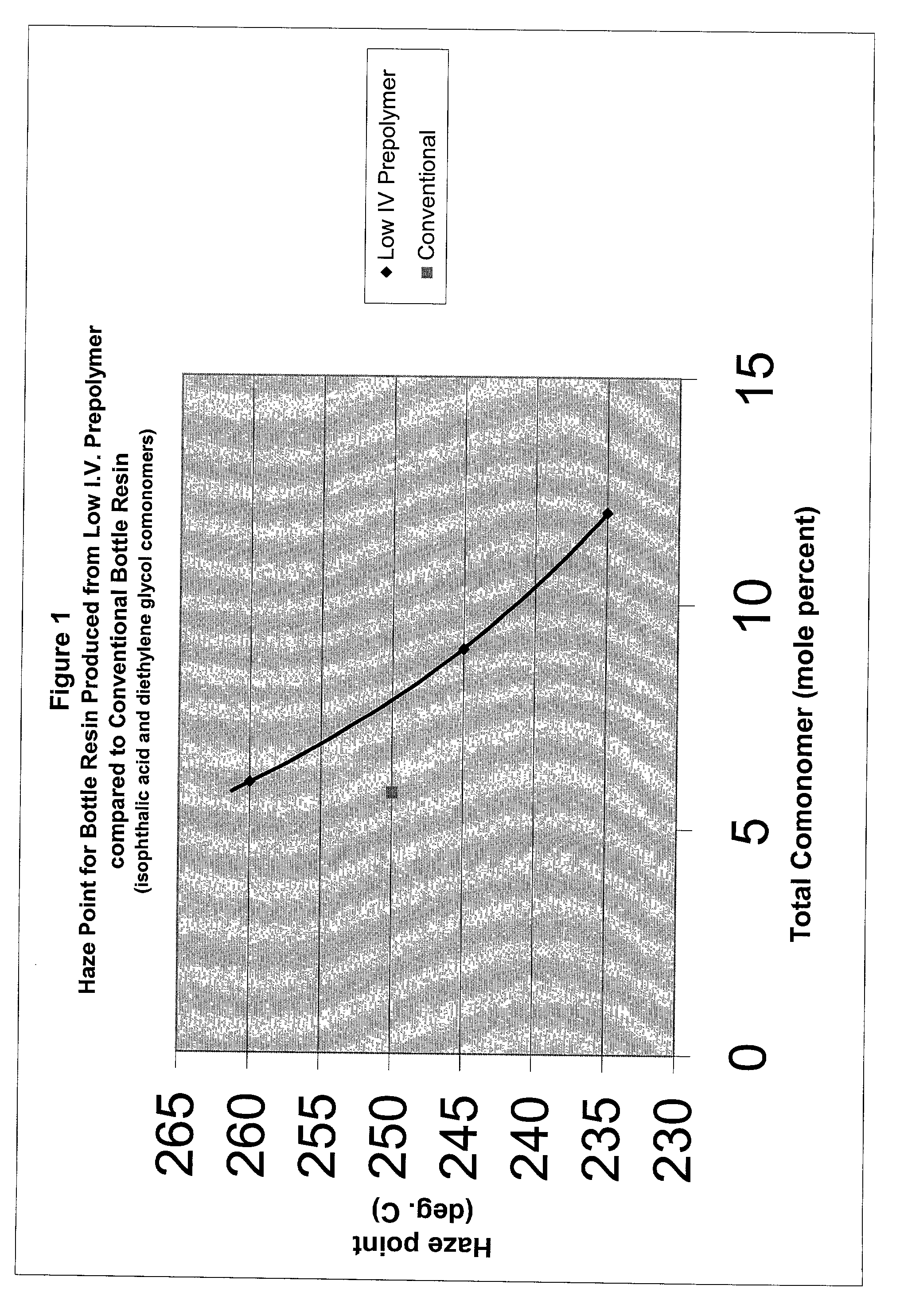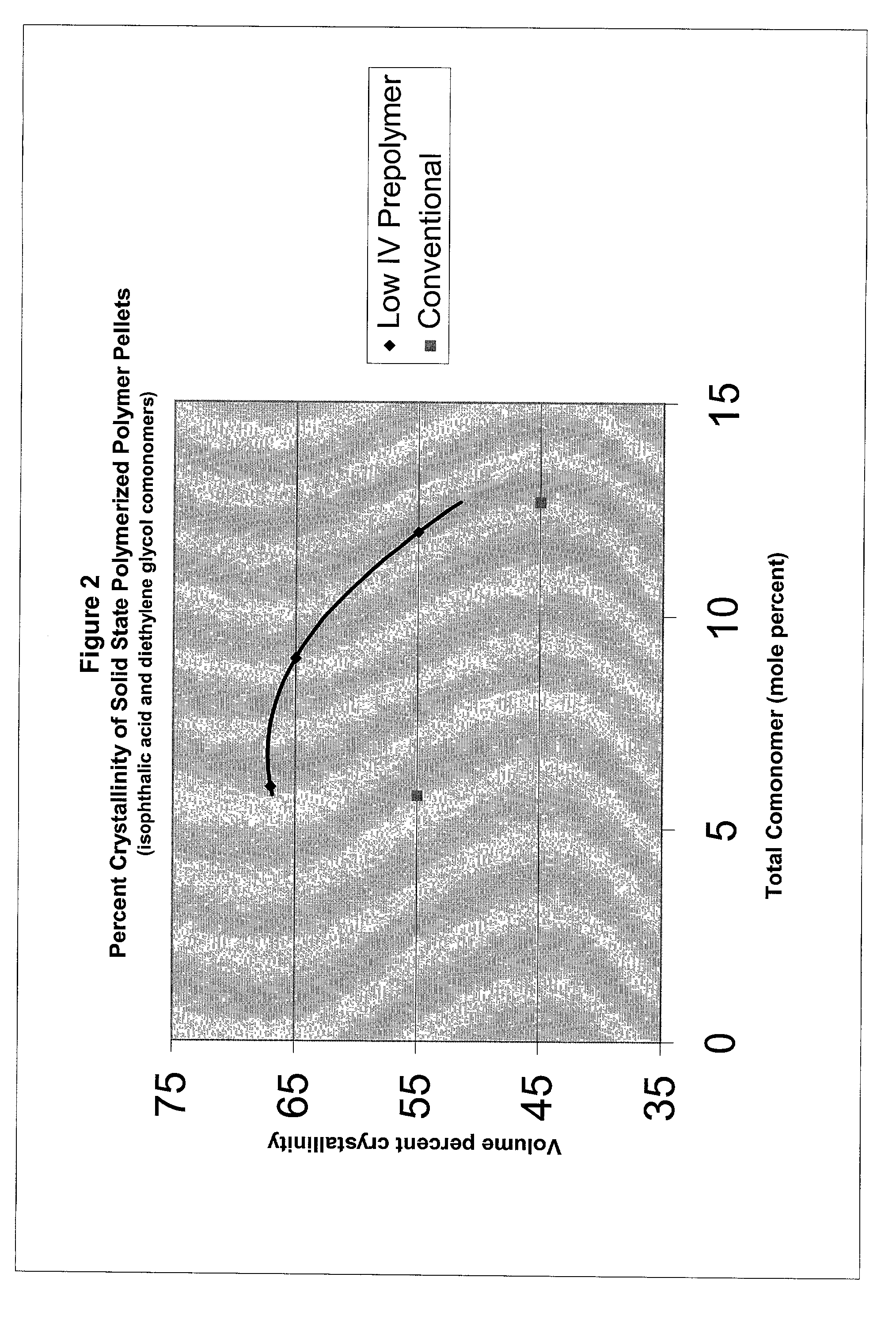Method of preparing modified polyester bottle resins
a technology of polyester bottle resin and modified polyester, which is applied in the field of cost-effective methods of making modified polyester bottle resin, can solve the problems of high haze point temperature, complicated conventional processing of resins produced according to dupont teachings, and relatively expensive melt phase polymerization, etc., and achieve excellent properties and cost-effective effects
- Summary
- Abstract
- Description
- Claims
- Application Information
AI Technical Summary
Benefits of technology
Problems solved by technology
Method used
Image
Examples
example 2
[0061] Polyester prepolymer with 3 mole percent isophthalic acid and intrinsic viscosity between 0.30 and 0.35.
[0062] Terephthalic acid, 41.71 kg, isophthalic acid, 1.29 kg, ethylene glycol, 17.58 kg, diethylene glycol, 0.08 kg, a 20% solution of cobalt acetate tetrahydrate in water, 26.4 g, and 1.3% antimony oxide in ethylene glycol, 1150.6 g, were blended together to make a paste. This paste was transferred to an esterification vessel heated to between 260.degree. C. and 270.degree. C. and pressurized to 3 bar. The overhead system in the vessel column separated and removed water produced during esterification from glycol, and the glycol was returned to the esterification vessel. The initial esterification batch provided a hot reactor heel to which more paste was added to the esterification vessel for efficient esterification. After the extent of esterification reached 98% and the pressure in the reactor was reduced to 1 bar, 52.7 kilograms of ester was transferred to a polycondens...
example 3
[0063] Polyester prepolymer with 6.0 mole percent isophthalic acid and intrinsic viscosity between 0.33 and 0.36.
[0064] Terephthalic acid, 40.42 kg, isophthalic acid, 2.58 kg, ethylene glycol, 17.58 kg, diethylene glycol, 0.08 kg, 20% solution of cobalt acetate tetrahydrate in water, 26.4 g, and 1.3% antimony oxide in ethylene glycol, 1150.6 g, were blended together to make a paste. This paste was transferred to an esterification vessel heated to between 260.degree. C. and 270.degree. C. and pressurized to 3 bar. The overhead system in the vessel column separated and removed water produced during esterification from glycol, and the glycol was returned to the esterification vessel. The initial esterification batch provided a hot reactor heel to which more paste was added to the esterification vessel for efficient esterification. After the extent of esterification reached 98% and the pressure in the reactor was reduced to 1 bar, 52.7 kilograms of ester was transferred to a polycondens...
example 4
[0065] Polyester prepolymer with 9.0 mole percent isophthalic acid and intrinsic viscosity between 0.30 and 0.32.
[0066] Terephthalic acid, 39.13 kg, isophthalic acid, 3.87 kg, ethylene glycol, 17.58 kg, diethylene glycol, 0.08 kg, 20% solution of cobalt acetate tetrahydrate in water, 26.4 g, and 1.3% antimony oxide in ethylene glycol, 1150.6 g, were blended together to make a paste. This paste was transferred to an esterification vessel heated to between 260.degree. C. and 270.degree. C. and pressurized to 3 bar. The overhead system in the vessel column separated and removed water produced during esterification from glycol, and the glycol was returned to the esterification vessel. The initial esterification batch provided a hot reactor heel to which more paste was added to the esterification vessel for efficient esterification. After the extent of esterification reached 98% and the pressure in the reactor was reduced to 1 bar, 52.7 kilograms of ester was transferred to a polycondens...
PUM
| Property | Measurement | Unit |
|---|---|---|
| crystallite size | aaaaa | aaaaa |
| density | aaaaa | aaaaa |
| density | aaaaa | aaaaa |
Abstract
Description
Claims
Application Information
 Login to View More
Login to View More - R&D
- Intellectual Property
- Life Sciences
- Materials
- Tech Scout
- Unparalleled Data Quality
- Higher Quality Content
- 60% Fewer Hallucinations
Browse by: Latest US Patents, China's latest patents, Technical Efficacy Thesaurus, Application Domain, Technology Topic, Popular Technical Reports.
© 2025 PatSnap. All rights reserved.Legal|Privacy policy|Modern Slavery Act Transparency Statement|Sitemap|About US| Contact US: help@patsnap.com


